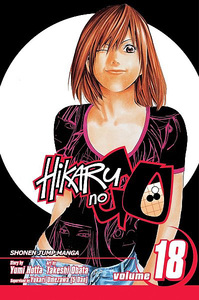Review
by Rebecca Bundy,Hikaru no Go GN 18
| Synopsis: |  |
||
Diverging away from the main storyline, this volume focuses on six side stories about six of the main characters: Akira Toya, Tetsuo Kaga, Asumi Nase, Yuki Mitani, Atsushi Kurata and Fujiwara-no-Sai. Akira and Mitani's stories center on what they're doing right before they meet Hikaru; Kaga and Asumi's stories expand upon what they're currently up to; Kurata's story pays a visit to the Go player before he first starts playing the game; and Sai's story follows him and a younger Hikaru on a little misadventure in an arts and pottery shop. |
|||
| Review: | |||
It's not uncommon for series, especially longer ones, to take a bit of a break from the main storyline to delve into chapters about other popular characters in order to flesh them out, tell a story that the mangaka or writer really wanted to tell but couldn't because it didn't fit anywhere else, or take a break from a story that may be getting too stressful or intense. Considering a major part of the main storyline was just wrapped up at the end of volume 17, this volume is the perfect time to sing these untold tales, especially since several are about characters who haven't appeared in the manga recently. Unfortunately, what could have been six unique glimpses into these characters' lives instead ends up being a collection of mostly uninteresting stories that will leave even die-hard fans of the characters disappointed. Akira Toya's story travels back in time to just before he meets his soon-to-be rival and shows him playing two minor characters, but aside from a sweet little moment between Akira and his father, the entire chapter lacks any real meaning and doesn't develop Akira beyond what we've already known about him since the beginning of the series. The most notable thing about this chapter is the art. Fans of little Akira will have plenty of cute and serious faces to gush over, but more importantly, comparing Akira at the beginning of the series to his youthful return really emphasizes how Takeshi Obata's lines and details have improved over the course of the series. Tetsuo Kaga's story steps back into the present as he returns to Haze Middle School to play some Shogi, but instead finds himself detoured to help the one remaining student in the Go club: Hitoshi Koike. Even though this story is supposed to be about Kaga, more time is spent focusing on Koike, whose easily excitable but wholly uninteresting personality makes it hard for the reader to root for this underdog. After two dull chapters, it's surprising to discover that Asumi Nase's story is actually interesting. Hikaru no Go has never hidden the fact that women aren't a big part of the Go world, but it's never touched upon the way those who don't play Go view female professional players. In this chapter, we actually get to see a unique side of Asumi, who is more comfortable around shady adults than she is a boy of her own age. The irony is that the adults are impressed with her skill and actually want to spend more time with her, yet her date, the only one her own age, is the one most intimidated by her. In the end, she realizes it's easier to struggle forward in the Go world as a professional female player than it is to be a “normal” 16-year-old girl. The next chapter on Yuki Mitani suffers from the same weakness as Akira's story does – namely, the flashback doesn't reveal anything we didn't already know about the character – and flounders even more when it wastes entire pages on Mr. Shu and Mr. Dake planning to teach Mitani a lesson. Interestingly enough, it's Atsushi Kurata's tale that stands out the most. Focusing on the relationship between a young Kurata and an English teacher-in-training, the chapter explores Kurata's knack for studying information about horse racers and then using these facts to guess the winner of a race. However, no amount of information can predict the unexpected, and that's where Kurata's intuition comes into play. At the end, a correlation is drawn between racing horses and playing Go: that is, no matter how much information or strategy you have, it's intuition that makes the difference between a good player and a great one. The volume tries to wrap up on a high note with the return of Sai, everyone's favorite curious and energetic ball of ethereal fluff, but trips over its own feet as it devolves into a chaotic mess in a pottery shop with yet another crooked seller trying to pawn fake merchandise off as the real deal to unsuspecting customers. The “trick” to Keicho's vase is a unique twist that includes some of the most beautiful drawings in the entire volume, but it's still not enough to save Sai's story from crumbling into a boring pile of rubble. Volume 18, even for its few shining moments, just doesn't bring much to the table. Very little Go is played, even less is accomplished in the way of character development, and unless you're the type who's determined to read everything related to Hikaru no Go, your collection will not suffer if you decide to leave this one out. |
| Grade: | |||
|
Overall : C-
Story : D
Art : B+
+ Skillful artwork shows how the artist has grown, and Asumi and Kurata's stories are somewhat interesting. |
|||
| discuss this in the forum (5 posts) | | |||